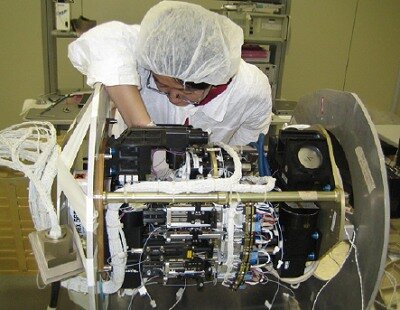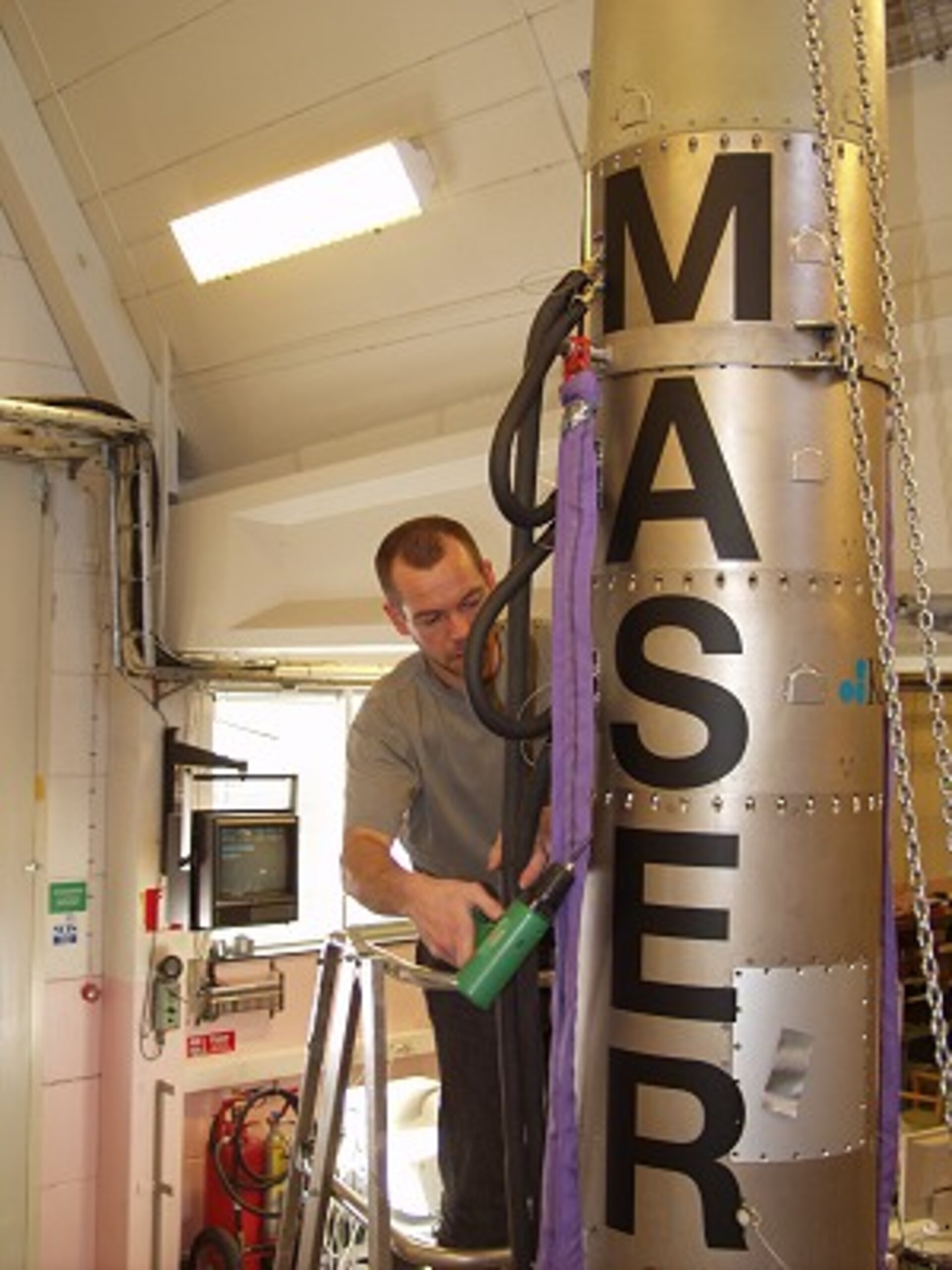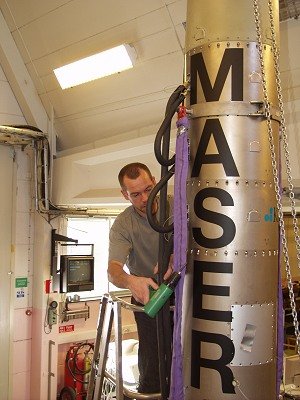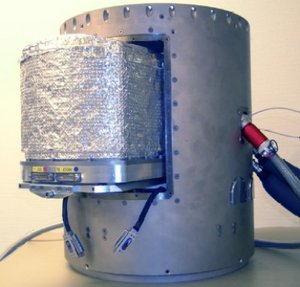Successful flight of Maser 10 rocket, marking the end of a historic era, ends with a hard landing
Early in the morning of 2 May 2005, at 07:00 Central European Summer Time (05:00 UT), the Swedish sounding rocket MASER 10 was successfully launched from the Swedish launch range Esrange, east of Kiruna, on a mission for the European Space Agency.
MASER 10 carried a set of five scientific experiments into a 6-minute weightless flight, culminating at an altitude of 250 km above the Earth's surface and approximately 150 km above the atmosphere. During the free-flight phase all experiment facilities on board MASER 10 worked correctly and transmitted in real time their experiment data to the ground via telemetry. At the end of the fallback phase to Earth, the parachute system in the recovery module did not work correctly, resulting in a hard landing, and the experiment hardware was seriously damaged.
Many European scientists and engineers observed this mission not only with a scientific interest, but also with very sentimental personal feelings, as the MASER 10 mission was launched into space by the 441st and last Skylark launcher system, which had marked European scientific research in the upper atmosphere and in open space for nearly half a century. Practically every European researcher involved in space experimentation has been involved at one moment in her or his professional life in a mission employing a Skylark rocket.
Scientific objectives fulfilled
"Unfortunately, the experiment facilities were damaged beyond repair at the hard landing," said Wolfgang Herfs, ESA's project manager for sounding rocket missions at the Directorate of Human Spaceflight, Microgravity and Exploration in Noordwijk (the Netherlands). "However, all indications show that the scientific objectives of the mission have largely been fulfilled. The rocket has transmitted experiment data, including video images, to the ground during the flight and the data stored onboard in memory cards and on videotapes are still readable, despite the shock at impact."
"Also 28 out of the 32 biological experiment units returned to Earth are in a state that they can be used for further scientific analysis. That was a very unfortunate end for an otherwise successful mission and at the same time the historic last flight of a Skylark launcher system, which has been the work horse of the ESA sounding rocket programme since its very beginning in 1966, under the responsibility of ESRO, the predecessor organisation of ESA for European space research."
Sounding rockets

Sounding rockets were used since the mid-1950's, as the name suggests, "to sound" (used here in the sense of "to probe") the upper Earth's atmosphere. However, if they fly higher, outside the Earth's atmosphere, they can also provide weightlessness to their payload during the thrustless free flight phase, the duration of which is determined by the apogee reached. It is typically in the range from 3 to 14 minutes. Since 1982, ESA's Microgravity Programmes make use of sounding rockets as a carrier for gravity-dependent life and physical research under weightless conditions.
All sounding rockets used by ESA for research under weightlessness are launched from Esrange near Kiruna in northern Sweden. Esrange is the only launch range in Europe where the impact area is totally uninhabited and large enough to allow for land recovery of the scientific payload. Besides the real time transmission of experiment data and telecommands from ground during flight, many experimenters also require the recovery of experiment samples and onboard-recorded data for the scientific evaluation of the experiment results in their home laboratory. Furthermore, the recovery of the experiment hardware after a nominal soft landing under parachute allows for its re-use in future missions.
The Esrange site and the MASER sounding rockets are operated by the Swedish Space Corporation. Esrange offers sufficient accommodation capability for the participants of a sounding rocket launch campaign. It also provides well equipped laboratories with clean benches, laminar flow benches, microscopes, centrifuges, autoclaves, incubators, etc., to enable the investigators to perform the final flight preparation of their samples as necessary.
A sounding rocket experiment on a MASER mission is typically accommodated on a circular platform with a useable diameter of 40 cm. This platform is mounted into the cylindrical external structure of the so-called "Experiment Module" by means of elastic dampers that reduce the impact of launch vibrations.
Skylark rocket

The scientific payload is launched on top a rocket system. MASER missions have been using in the last years the 2-stage Skylark 7 rocket. This solid propellant launch vehicle consists of a "Goldfinch" first stage and a "Raven XI" second stage motor.
MASER 10 was the historic 441st and last flight of a Skylark sounding rocket. This marked the end of nearly half a century of successful Skylark operations that began with the first Skylark launch from Woomera, Australia, for a research mission in the framework of the International Geophysical Year of 1957. This was the same year that also saw the first flight of a Sputnik satellite.
Skylark was developed by the British Royal Aeronautical Establishment in Farnborough, in conjunction with the Rocket Propulsion Establishment in Westcott. Initially funded by the UK government, Skylark has been produced and operated since 1966 on a commercial basis, first by British Aerospace (now EADS Astrium), then Matra Marconi Space and finally, since 1999, by Sounding Rocket Services Ltd in Bristol.
The industrial production of Skylark motors ended already in November 1994, but the available stock of launchers allowed the continuation of flight operations for microgravity sounding rocket missions of ESA and DLR, until the MASER 10 launch that used the very last Skylark launcher available.

Undoubtedly, Skylark has been one of longest-lasting and most successful rockets of all time. Many European researchers in gravity-dependent scientific research has dealt in his professional life with an experiment that was launched on a Skylark rocket.
For future sounding rocket missions, starting from November 2005, ESA will use Brazilian-built two-stage VSB-30 rockets instead of Skylarks. The first prototype of the VSB-30 rocket was successfully launched by a joint team from the Brazilian Aeronautical and Space Institute, the Brazilian Aerospace Technical Centre CTA/IAE and the German Space Centre DLR on 26 October 2004 from the Alcântara launch site, located in the Brazilian state of Maranhão, as part of a co-operation agreement established in the 1970s.
Despite its honourable age, the last Skylark rocket provided up to the end of its operational lifetime a faithful service and carried MASER 10, after a burning time of 3.7 seconds of the first stage and 39 seconds of the second stage, to an altitude of 252 km. From the moment MASER 10 left the atmosphere at an altitude of approximately 100 km, one minute and six seconds after lift-off, until the moment it re-entered the atmosphere, six minutes later, it was physically speaking in free-fall (even during the ascent flight), and hence in weightless conditions, together with all the experiment facilities onboard.
Maser 10 payload

Apart from the Skylark launch vehicle, MASER 10 comprised four experiment modules, a service module and a recovery system. Together, these modules are known as "the payload". The payload separated from the second stage of Skylark one minute after lift-off, at an altitude of approximately 75 km.
With the kinetic energy as its sole means of locomotion, the payload continued a ballistic flight up to an apogee (i.e. the highest point of the trajectory) of 252 km and then fell back to Earth, entering the atmosphere again at seven minutes and 23 seconds after lift-off.
Three minutes later, a complex sequence for the gradual opening of two different parachute systems should start, first, for the so-called drogue parachute at an altitude of 5.5 km, and then for the main parachute at an altitude of 3.4 km. However, this sequence was not executed correctly.
Inquiry Board
The first results of the inspection of the payload and the analysis of telemetry and tracking data indicated that the drogue parachute did not succeed to pull the main parachute out of its canister. As a consequence, the payload hit the ground at relatively high speed.
"The European Space Agency will now set up an Inquiry Board composed of ESA and non-ESA specialists which will thoroughly investigate the reasons for the failure of the recovery system and the malfunction of the service module of MASER 10 and recommend corrective measures to avoid that such unfortunate failures will happen again in the future," said Werner Riesselmann, Head of the Payloads Division in the ESA Directorate of Human Spaceflight, Microgravity and Exploration which oversees the Sounding Rocket Programme in ESA.






